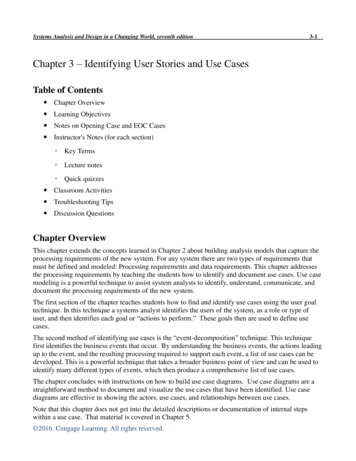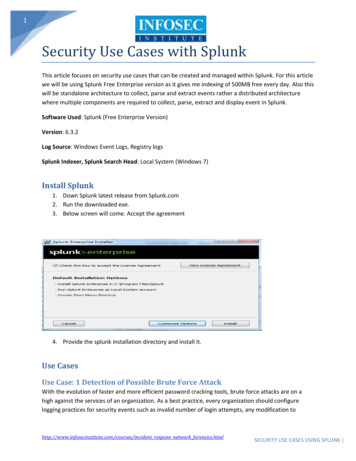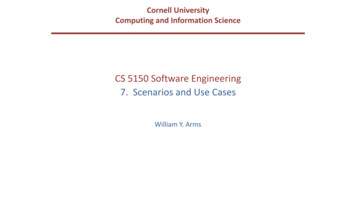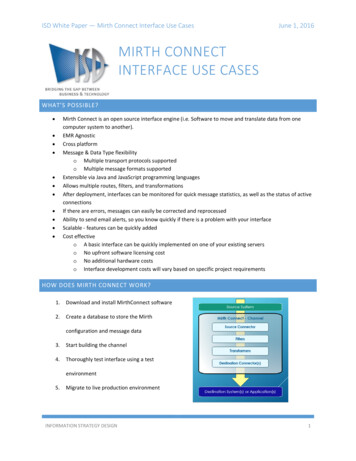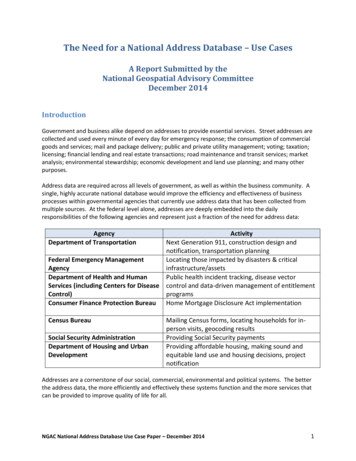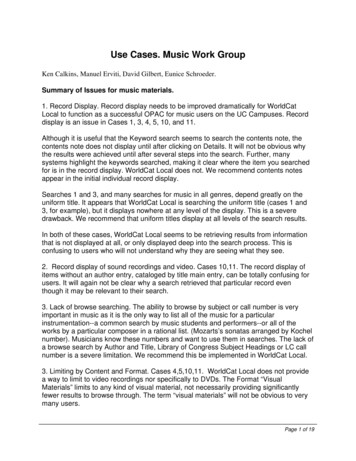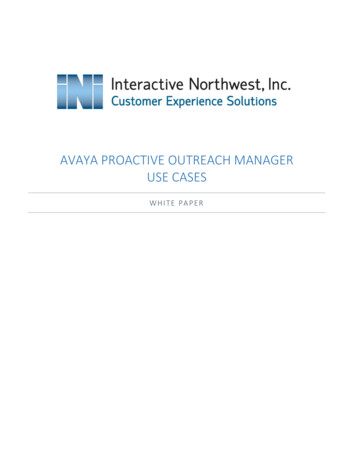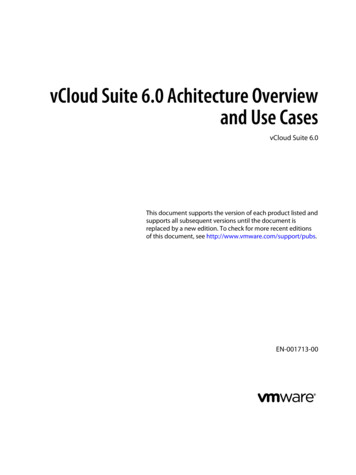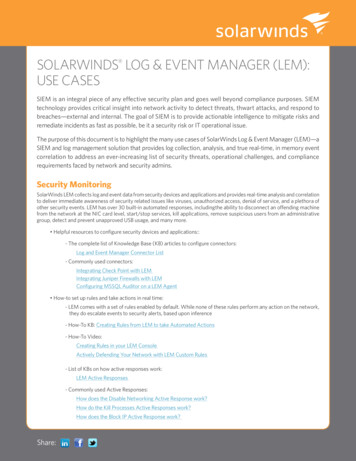
Transcription
Use CasesReference: Craig Larman, Applying UML and Patterns, Ch. 6
Use Case What it is: Text story Widely used to discover and record (mostly functional)requirementsWhat is it about: Some actor(s) using a system to meet specific goals Answering questions: Who is using the system, what are their typicalscenarios of use, and what are their goals?What it is NOT:Not object-oriented Not a diagram UML use cases diagrams are “secondary-value”artifactsFocus: use cases, not use case diagrams
Example: Point of Sale1.Customer arrives at a checkout ( goods).2.Cashier uses POS system to record items.3.System presents a running total and lineitem details.4.Customer enters payment information,which the system validates and records.5.System updates inventory.6.Customer receives receipt from the systemand leaves.
Actors, Scenarios, and Use CasesActor: entity that shows a behavior, e.g.: a person (role), computer system, or organizationScenario: specific sequence of actions and interactionsbetween actors and a systemuse case instancesinge path of using the systeme.g., purchasing 10 items with cash (or even more detailed)Use case: collection of related success & failurescenarios that describe an actor using a system tosupport a goal
Use Case Example with Scenarios(casual format) UC Handle Returns Main success Scenario: A customer arrives at acheckout with items to return. The cashier usesthe POS system to record each returned item Alternate Scenarios: if the customer paid by credit . If the item identifier is not found in the system If the system detects failure to communicate with theexternal accounting system
Use-Case ModelSet of all written use casesModel of the system’s functionality andenvironmentUnified Process (UP) defined artifact within therequirements disciplineUP also requires glossary.May optionally include a UML use case diagramuse cases, actors, and their relationshipscontext diagram
Three Kinds of ActorsPrimary actorhas user goals fulfilled through using services of the system underdiscussiondrives the use casesSupporting actorprovides a service to the system under discussione.g., payment authorization serviceimplies: clarification of external interfaces and protocols neededOffstage actorhas an interest in the behavior of the use case, but is not primary orsupportinge.g., a government tax agency
Use Case FormatBriefSuccinct one-paragraph summaryusually the main success scenariodone during early requirements analysisshould take only a couple of minutesCasualinformal paragraph formatmultiple paragraphs covering various scenariosFully dresseddetails all steps and variationsincludes supporting sections such as preconditions and successguaranteesmainly done after many use cases are identified and during earlyrequirements workshop for high-value and high-risk requirements(e.g., core architectural)
A Template for Fully Dressed Style Use case name Scope Level Primary actor start with a verb the system under design user goal or subfunction level calls on the system to deliver aserviceStakeholders and interests who cares about this use case, andwhat do they want? Preconditions what must be true on start, andworth telling the reader Success guarantee (postcondition) what must be true on successfulcompletion, and worth telling the reader Main success scenario a typical, unconditional happypath scenario of success Extensions alternate scenarios of successand failure Special requirements related non-functionalrequirements Technology and datavariations list varying I/O methods and dateformats Frequency of occurrence Miscellaneous
Coffee Maker ExampleExample of a “semi” fully dressed use ls/tutorials/coffee maker/
Template for a fully dressed use case
Write in an Essential Style(early phase)Keep the user interface outFocus on actor intentUser’s intentions and system’s responsibilities ratherthan their concrete actionsExample Manage Users: 1. Administrator identifies self. 2. System authenticates identity.Another is concrete style that embeds user interface decisions- avoid during early analysisExample 1. Administrator enters ID and Password in a dialog box
Write Black-Box Use CasesFocus on what the system must do, i.e., the behavior or functional requirements Not on how it will do (the design)Examples:Good: The system records the saleBad:The system writes the sale to the database.Worse: System generates SQL INSERT statement for the sale
Take an Actor and Actor-Goal PerspectiveUse case definition by JacobsonA set of use-case instances, where each instance isa sequence of actions a system performs thatyields an observable result of value to a particularactor [Jacobson]Write requirements focusing on the users/actors of a system, asking about their goals and typical situations and what they consider a valuable result
Actor-Goal List
One Column vs Two Column FormatTwo column emphasizes interaction
How to Find Use Cases?Choose the system boundarywhat you are building?who will be using the system?what else will be used that you are not building?Find primary actors and their goalsbrainstorm the primary actors firstwho starts and stops the system?who gets notified when there are errors or failures?Define use cases that satisfy user goalsprepare an actor-goal list (and not actor-task list)in general, one use case for each user goalname the use case similar to the user goal
What Tests Can Help Find Useful UseCases?Which of these are valid use cases? Negotiate a Supplier Contract Handle Returns Log in Move Piece on the Game Board
What Tests Can Help Find Useful UseCases?Which of these are valid use cases? Negotiate a Supplier Contract Handle Returns Log in Move Piece on the Game BoardAll of these can be use casesat different levels,depending on the system, boundary, actors, andgoals
What Tests Can Help Find Useful UseCases?Rather than asking ”What is a valid use case?”More practical question: “What is a useful level of focus to express usecases for application requirements analysis?”Rules of thumb The Boss Test The EBP Test The size test
What Tests Can Help Find Useful UseCases?The boss test“What have you been doing all day?” Your reply “logging in!” Is your boss happy? No value? No good use case!The Elementary Business Process (EBP) testa task performed by one person in one place at one time, inresponse to a business event, which adds measurable businessvalue and leaves data in a consistent stateGood Examples: Approve Credit or Price OrderBad Examples: delete a line item or print the documentThe size test Just a single step in a sequence of others - not good!
Applying TestsNegotiate a supplier contractMuch broader than EBP, rather a business use caseHandle returnsOK with the Boss. EBP. Size is good.Log inBoss is not happy is this is all you do all day!Move piece on game board Single step – fails the size test.
Use Case (Context) Diagrams:Suggested Notation
Use Case DiagramsContext diagram of the systemShows boundaryWhat lies outside of itHow it gets usedShould be done in conjunctionwith an actor-goal listDownplay diagramming, Keep it short and simpleFocus on textDo not focus on use case relationships
Alternative Actor Notation
Use Cases form Basis for Others
Use Cases in Iterative DevelopmentFunctional requirements are primarily capturedin use casesUse cases drive the iteration planning and workEasy for users to understandInfluence user manual/documentationFunctional or system testing corresponds to thescenarios of use casesIndependent of implementing technologyUI shortcuts for most common scenarios
More ki/doku.php
Questions/Comments/Thoughts?
Credits Contents adopted from Applying UMLand Patterns - Larman andwww.craiglarman.com
Example: Point of Sale 1.Customer arrives at a checkout ( goods). 2.Cashier uses POS system to record items. 3.System presents a running total and line-item details. 4.Customer enters payment information, which the system validates and records. 5.System updates inventory. 6.Customer rece
